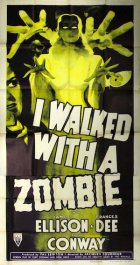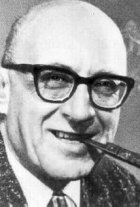
I Walked with a Zombie Page #2
- APPROVED
- Year:
- 1943
- 69 min
- 650 Views
The stars seem very close and there is always movement in the
sky, as if it were alive -- falling stars and comets, lively
as the flying fish.
EXT. DECK OF SCHOONER -- NIGHT
Betsy is seated on the cabin top just abaft of the foremast.
She is looking out toward the sea and her expression is
ecstatic. She is completely lost in the beauty that she
feels, sees and smells.
BETSY'S VOICE
I smelled the spicy smells coming
from the islands -- I looked at those
great glowing stars -- and I felt the
warm wind on my cheeks and I breathed
deep and every bit of me inside
myself said, "How beautiful --"
The CAMERA DRAWS BACK to SHOW a tall, masculine figure
leaning against the foremast, behind Betsy. This is Paul
Holland. As we see him, we hear his voice.
HOLLAND:
It is not beautiful.
BETSY:
(surprised but smiling)
You read my thoughts, Mr. Holland.
HOLLAND:
It's easy enough to read the
thoughts of a newcomer. Everything
seems beautiful because you don't
understand. Those flying fish --
they are not leaping for joy.
They're jumping in terror. Bigger
fish want to eat them.
That luminous water -- it takes its
gleam from millions of tiny dead
bodies. It's the glitter of
putrescence. There's no beauty
here -- it's death and decay.
BETSY:
You can't really believe that.
A star falls. They both follow its flight with their eyes.
HOLLAND:
(pointing to it)
Everything good dies here -- even
the stars.
He leaves his position by the mast and walks aft.
The group of negroes at the mainmast. They have stopped
singing and they sit about the charcoal brazier. They are
eating, tearing at the meat with cruel, greedy, animal
gestures. Holland walks past them on his way aft.
Betsy is puzzled and a little alarmed by Holland's strange
utterances and his queer behavior. Over this shot of Betsy
looking off at him, we hear her as narrator.
BETSY:
(narrating)
It was strange to have him break in
on my thoughts that way. There was
cruelty and hardness in his voice.
Yet -- something about him I liked --
something clean and honest -- but
hurt -- badly hurt.
FADE OUT:
FADE IN:
EXT. VILLAGE OF ST. SEBASTIAN -- DAY
St. Sebastian is a drab little West Indian village. The
shacks and houses of wood, lath and plaster seem to be
falling apart. Over the doorway of one of the buildings --
evidently an administrative office -- hangs an American flag,
indicating the government of the island. The hard-packed
dirt in the roadway is overgrown with weeds. Everywhere, and
moving indolently, are the little, badly nourished negroes,
some of them tending stalls and sidewalk vending booths,
others walking idly. Betsy, followed by a black sailor with
her suitcases, comes down the gangway. Parallel to this
gangway is another.
Up the second gangway, in file, black stevedores with bundles
of sugar cane and small bales of sisal hemp on their heads,
go up to the boat.
On the dock, Betsy makes her way through a group of clamorous
children, vendors and beggars. As the black sailor puts her
luggage into an umbrella-topped surrey drawn by a gaunt mule,
she stops, delighted, before a great basket filled with
enormous white flowers. The man seated beside the basket
seems to be asleep, his face hidden by the drooping brim of a
straw hat. Betsy picks up one of the blooms, smells it and
then looks at the vendor.
BETSY:
How much is this?
The vendor wakens and lifts his head, revealing a face
bloated and scarified by yaws, a hideous nightmare face.
Betsy, startled, steps back, letting the flower drop. Paul
Holland, passing her, looks at this little tableau of horror
and disgust.
HOLLAND:
(in passing)
You're beginning to learn.
Betsy looks after him as he walks away into the village.
DISSOLVE:
EXT. ROAD TO FORT HOLLAND -- DAY -- (PROCESS)
An umbrella-topped surrey, drawn by a gaunt mule and piloted
by an old coachman in dirty white singlet, a top hat with a
cockade on his graying hair, is making its way along a dusty
road between fields of sugar cane. In the distance, the sea
is visible and above it the great billowing white clouds of
the Caribbean. Betsy, seated on the back seat of the
carriage, is bending forward to listen to the old man.
COACHMAN:
Times gone, Fort Holland was a
fort...now, no longer. The
Holland's are a most old family,
miss. They brought the colored
people to the island-- the colored
folks and Ti-Misery.
BETSY:
Ti-Misery? What's that?
COACHMAN:
A man, miss -- an old man who lives
in the garden at Fort Holland -
with arrows stuck in him and a
sorrowful, weeping look on his
black face.
BETSY:
(incredulous)
Alive?
COACHMAN:
(laughing, softly)
No, miss. He's just as he was in
the beginning -- on the front part
of an enormous boat.
BETSY:
(understanding and amused)
You mean a figurehead.
COACHMAN:
(warming up to his
orating)
If you say, miss. And the enormous
boat brought the long-ago Fathers
and the long-ago Mothers of us all
- chained down to the deep side
floor.
BETSY:
(looking at the endless
fields and the richly
clouded blue sky)
But they came to a beautiful place,
didn't they?
COACHMAN:
(smiling and nodding as
one who accepts a
personal compliment)
If you say, miss. If you say.
DISSOLVE:
The jugheaded mule slowly pulls the carriage into the scene.
This beast comes to a somnolent stop without the coachman so
much as touching the reins. As the man climbs down and
starts to take the luggage out of the carriage, Betsy looks
through the wrought-iron gate into the garden.
Fort Holland is a one-story house built around the garden,
with low covered porches to give shade and breezeway. At the
open end of the U is a great gate much like the wrought-iron
gates of New Orleans. Through this Betsy can see the garden
and its profusion of verdure: azalea, bougainvillea, roses --
much like California planting; no exotic orchids or man
eating Venus Jugs -- just ordinary, pretty, semi-tropic
flowers and shrubs.
The separate rooms are open to the garden, but have jalousies
of thin wood to give privacy when needed. At one corner
stands a big, stone tower, obviously a relic of some previous
building. The walls of the house have been built right up to
and around the tower so that it has become part of the
building itself. On the garden side of the tower is the
fountain. The most outstanding feature of this spring or
fountain, which flows from a crevice in the stones of the
tower, is that instead of falling directly into the cistern
it falls first onto the shoulders of the enormous teakwood
figurehead of St. Sebastian. From the shoulders of the saint
it drips down in two runnels over his breast. The wooden
breast of the statue is pierced with six long iron arrows.
The face is weathered and black. Only a few bits of white
paint still cling to the halo above his head. Betsy and the
coachman come up to the grillwork of the gate. Betsy looks
around the garden, while the old coachman reaches up and
pulls a bell rope suspended from the gate. As the bell
begins to ring, he pushes the gate open. Betsy walks
through.
Translation
Translate and read this script in other languages:
Select another language:
- - Select -
- 简体中文 (Chinese - Simplified)
- 繁體中文 (Chinese - Traditional)
- Español (Spanish)
- Esperanto (Esperanto)
- 日本語 (Japanese)
- Português (Portuguese)
- Deutsch (German)
- العربية (Arabic)
- Français (French)
- Русский (Russian)
- ಕನ್ನಡ (Kannada)
- 한국어 (Korean)
- עברית (Hebrew)
- Gaeilge (Irish)
- Українська (Ukrainian)
- اردو (Urdu)
- Magyar (Hungarian)
- मानक हिन्दी (Hindi)
- Indonesia (Indonesian)
- Italiano (Italian)
- தமிழ் (Tamil)
- Türkçe (Turkish)
- తెలుగు (Telugu)
- ภาษาไทย (Thai)
- Tiếng Việt (Vietnamese)
- Čeština (Czech)
- Polski (Polish)
- Bahasa Indonesia (Indonesian)
- Românește (Romanian)
- Nederlands (Dutch)
- Ελληνικά (Greek)
- Latinum (Latin)
- Svenska (Swedish)
- Dansk (Danish)
- Suomi (Finnish)
- فارسی (Persian)
- ייִדיש (Yiddish)
- հայերեն (Armenian)
- Norsk (Norwegian)
- English (English)
Citation
Use the citation below to add this screenplay to your bibliography:
Style:MLAChicagoAPA
"I Walked with a Zombie" Scripts.com. STANDS4 LLC, 2025. Web. 22 Feb. 2025. <https://www.scripts.com/script/i_walked_with_a_zombie_875>.







Discuss this script with the community:
Report Comment
We're doing our best to make sure our content is useful, accurate and safe.
If by any chance you spot an inappropriate comment while navigating through our website please use this form to let us know, and we'll take care of it shortly.
Attachment
You need to be logged in to favorite.
Log In